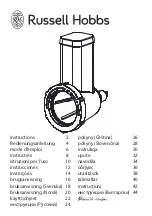
EXPANDABLE 528
D E H Y D R A T O R
Owner’s Manual User Guide
14
Reconstitution
RECONSTITUTION
Reconstitution refers to putting moisture back into food. You will often want
to reconstitute dried foods before adding to recipes, using as side dishes or
combining with other ingredients.
• When allowed to soak in liquid, dried food will swell to its original shape
and size.
• Place food in a container with enough water or liquid to cover. Then soak
until it is at desired consistency.
• Refrigerate while soaking to prevent spoilage. Do not add seasonings
during this process.
• You may use liquids other than water, including juices, consommé, milk,
etc.
• Try not to use more liquid than necessary for reconstitution, as nutrients
will be drained away with the excess.
• There is no need to reconstitute ahead of time when making soups. Dried
vegetables can be added directly to the soup about one hour before
serving.
• For chopped or shredded vegetables and fruits to be used in cookies, no
reconstitution is usually needed. If the pieces are crisp and dry, sprinkle
with 1 Tbsp water per ½ cup of dried food.
• For vegetables and fruits to be used in souffl és, pies, quick breads,
doughs or batters, use 2 parts water to 3 parts (by volume) dried food.
• For vegetables and fruits which will be cooked in liquid, such as
vegetable side dishes, fruit toppings, and compotes, use 1 to 1½ parts
water to 1 part dried food. Extra liquid may be required for proper
cooking.
• Chopped and shredded foods reconstitute quickly. Generally, 15 to 30
minutes is suffi cient. Whole pieces or slices of fruit or vegetables and
meat cubes take longest to reconstitute and are best left to soak in the
refrigerator overnight.
• Some foods take longer to reconstitute than others. Carrots and beans
require more time than green peas or potatoes. A rule of thumb: those
that take the longest to dehydrate will take the longest to reconstitute.
• If food cannot be soaked as long as necessary, place in boiling water,
remove from stove, and let stand 2 to 3 hours.
• Rehydrating meat is usually completed in 1 to 4 hours by soaking in an
equal amount of water (in the refrigerator), or by gently simmering in
water. Use only enough water to cover meat.
• If you drain reconstituted foods, save the liquid. This liquid has great
nutritional value. Freeze for use in soups, leathers, pies or compotes.
• Do not add spices, salt, bouillon cubes or tomato products until
vegetables are reconstituted and cooked. These items may hinder
rehydration.
15
Fruit
FRUIT
Dried fruit has no preservatives, is nutritious, and has a naturally sweet taste.
Suggested uses: snacks, cookies, pies, cobblers, cakes, breads, ice creams,
pancakes, jams, fruit leather, sweetener for waffl es or cereals and more.
Process:
• Select fi rm, ripe fruit (not overly ripe), free of bruises and blemishes Sort
through grapes and berries. Remove those with imperfections.
• Wash fruit that is to be dehydrated with the skin.
• Peel fruits, if desired or necessary. For easy peeling of fruits such as
peaches, dip in boiling water until skin cracks.
• Waxy skinned fruits like cherries, cranberries, grapes (raisins), and
blueberries that will be left whole must have their skins poked or be
placed in boiling water for 1-2 minutes to remove waxy coating.
• Berries may be blanched or steamed to pop their skins which will shorten
the dehydration time. Cut, remove stems, stones, pits, cores and seeds.
Cutting uniform slices will allow food to dry evenly.
• Cut fruit into slices, pieces or halves. Uniform slices ¼” are best for most.
• See PRETREATING section for fruits that may turn dark during the drying
process.
• Use mesh inserts for any small fruits or pieces that might fall through the
holes in the dehydrator trays.
• Place fruit evenly on trays. If using more than 4 trays rotate once during
drying time.
Tutti-Fruit:
Dissolve fl avored gelatin according to directions on package. Soak apple or
pear slices in mixture for 10 minutes. Blot dry on paper towels. Dehydrate.
















































